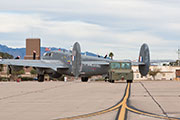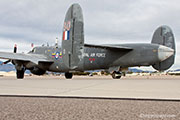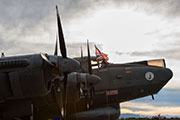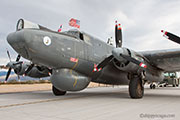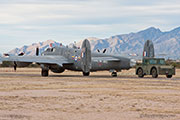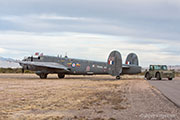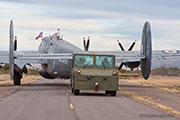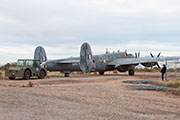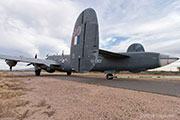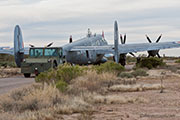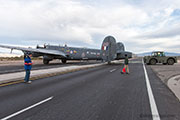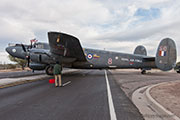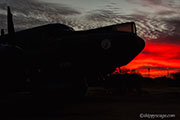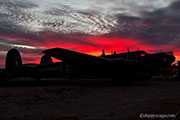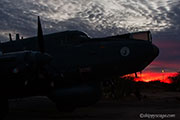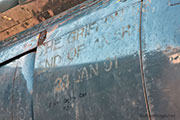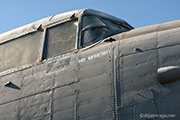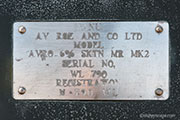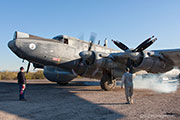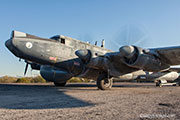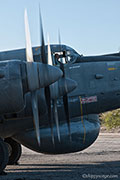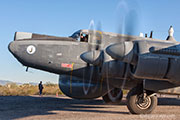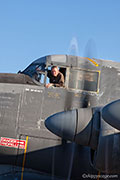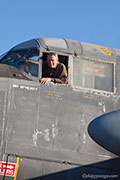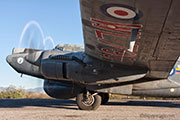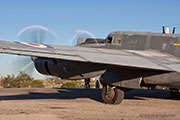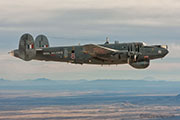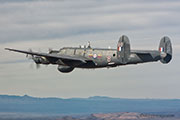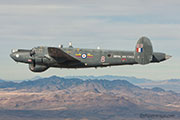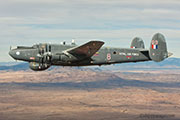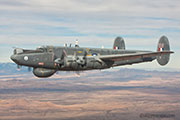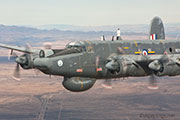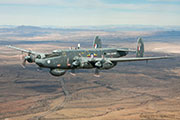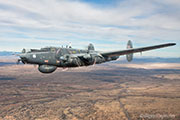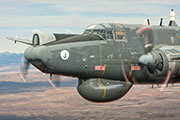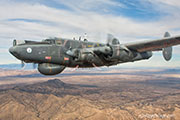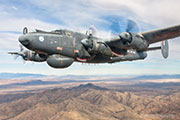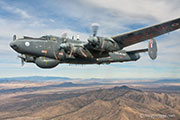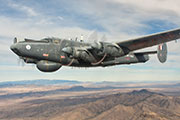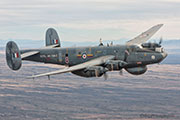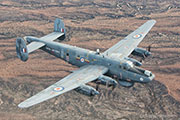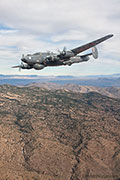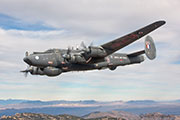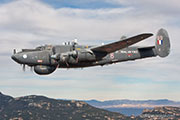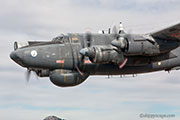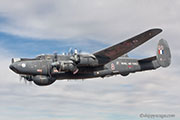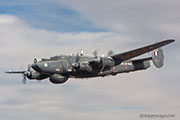The world's last airworthy Avro Shackleton MR.2/AEW.2 completed what may be its last flight on 16 December 2007, as it relocated from the Commemorative Air Force (CAF) ramp at Midland, Texas to the Pima Air and Space Museum in Tucson, Arizona.
The move ended two years of uncertainty over the "Shack's" fate. During that time, the aircraft's owner, Michael Collett of Atlantique Classic Flight, had been between a rock and a hard place: the Civil Aviation Authority in the UK would issue a ferry permit for the aircraft to fly back home, but once there they would ground her unless a very costly spar replacement was performed.
The aircraft had been for sale in the USA for a couple of years, but being in a country unfamiliar with the type, plus the fact that it never wore 'stars and bars', meant that no interested parties ever appeared. The grey old lady was slowly dying under layers of Texas dust despite the efforts of the CAF, who had kindly allowed the aircraft to be parked on its ramp for free and who would also hangar her when the group's other aircraft were away.
The Pima Air and Space Museum (PASM) was more than happy to offer WL790 a new home. Given the dry, warm climate in Arizona together with the experienced staff at Pima, this was probably the best place for the Shackleton to retire to. The next step was to get her there!
The Last Airworthy What?
For those who have never heard of or seen this aircraft, a brief history. If the lines look slightly familiar, it is because the Shackleton was based on the Avro Lincoln, itself a derivative of the famous Avro Lancaster bomber. Originally to be called the Lincoln Mk3, it was renamed Shackleton (after the famous British explorer) after development. It shared the same spar and wing as the Lincoln, but was shorter, fatter and more powerful.
Why the contra-rotating propellers? In the aftermath of the 2nd Word War the UK had very little money so wherever possible the Shackleton used parts that already existed. As the Griffon engine was far more powerful than the Merlin fitted to the Lincoln, it would require larger and longer propeller blades. To accommodate larger props the engines mounts would have to be further apart and ground clearance would have been an issue. The fix was to use contra-rotating props, which allowed the Lincoln wing to be used unmodified. A further advantage was that the amount of torque on take-off would be reduced, which for a tail-dragger is a great benefit.
The aircraft was designed from the outset as a maritime patrol aircraft for the Royal Air Force (RAF) and went into service in 1951. The Shackleton was replaced in the maritime reconnaissance role by the Hawker-Siddeley Nimrod, beginning in 1969. But the remaining airframes gained a new lease on life, when delays in the Nimrod AEW program created an urgent RAF requirement for an "interim" Airborne Early Warning aircraft. The MR.2 version of the Shackleton was fitted beneath the cockpit with the Fairey Gannet's radar, and the AEW.2 version was born. The disastrous Nimrod AEW project was ultimately abandoned, leaving the Shackleton AEW.2 to solder on until the RAF purchased the E-3 Sentry in 1991.
Back to Life
A crew was gathered from California, Colorado and England to nurse the aircraft back to health for the ferry flight. Their ambitious plan was to get the aircraft up and running in less than a week. The crew comprised Captain Dick Markgraf, Co-Pilot Clark "Marty" Martin, Chief Engineer Ben Cox, Flight Engineer Dwight Bales, and Scanner Norman Thelwell.
On Monday, 10 December, the aircraft was towed into the hangar at Midland to be prepared for its ferry flight. Most work concentrated on the engines, which had not been run in over two years.
First on the list was removal of all engine covers, cowlings, prop spinners, inspection plates and hole plugs, to clear away bird nests and inspect and lubricate all components. Next came cleaning and checking oil screens, draining oil sumps, servicing oil and coolant tanks, inspecting the engines and props, servicing the prop translation units and reinstalling the spinners.
The hydraulic system was serviced and bled, all actuators were wiped down, the flaps and bomb doors were cycled then re-serviced, and the gear struts were cleaned and serviced along with the tires. There were some hydraulic leaks at first, which eventually dried up.
Floyd Walpole and crew from Wilco Batteries in Wichita, was able to send two serviceable batteries as the ones fitted had gone bad after three years. With the new batteries installed, ground power was connected and checks were made of the intercom, radios, inverters, compass system, gyros, engineer's panel, etc. After a lot of coaxing and swapping of headsets, the crew were able to get the intercom system working -- although with an annoying squeal. The #1 RT, meanwhile, would transmit but not receive. This later cleared itself.
There was no response from the charge air temps or radiator flaps, although the latter could still be opened manually.
Thursday, 13 December was spent on the huge task of pre-oiling the engines, which required adapting the CAF's oil cart to allow it to hook up to the Griffon engines. A ground run was accomplished that same afternoon with all four engines performing smoothly under low power. The only snag was a fuel leak in the number 1 engine master fuel cock.
On Friday, 14 December, a new fuel cock was sourced and replaced - with difficulty, due to the typical British Standard spanners not being standard for anyone else! A Metric wrench sufficed until Ben Cox's arrival on Saturday, when he would fix everything in sight to his usual high standard. The fuel cock still leaked, so the fault was deemed to be in the valve itself. With no spare available, it was decided to seal the valve until Ben could work on it. (As a side note, Ben was one of the mainstays in the recent rebuild of the Battle of Britain Memorial Flight's Lancaster.)
With the arrival on Saturday of the master engineer, the fault was found to be a stuck brake maintaining valve, and once this was freed everything operated as designed.
On Sunday morning, full engine runs were performed. With no leaks to be found, the Shack was deemed fit for flight. While she was being fueled, the crew had a hard time breaking down the special Shackleton tow-bar, which had rusted almost solid. They ended up proving the old adage: if in doubt, a hammer will fix most things!
On Its Way!
Mr McHenry took off from Midland at 12:43 local time, on the originally scheduled date of Sunday 16 December. She performed a sweeping flypast before heading off to Arizona.
I was pleasantly surprised to be able to hear the low rumble at 8,000 feet and 180 knots while inside the chase plane. It brought a lump to my throat during the air-to-air sortie knowing that we would be among the last to see - and hear! - a Shack fly.
Having made good time due to a stiff tailwind, Mr McHenry arrived overhead DMAFB at 14:25 local. A request for a couple of flybys was rejected by Air Force ATC, and Dick was forced to perform a break at 800 feet AGL from the West side due to winds.
On landing both British and American flags were raised from the cockpit in honour of the joint effort from both sides of the Atlantic to bring the Shack to its new home. The crew were met by 355th Fighter Wing Commander Col. Kent Laughbaum, PASM staff and some local press.
It was a bittersweet day for Dick - the last flight of a Shackleton MR.2/AEW.2 and on his birthday to boot! Unbeknown to him, his wife Aura had brought his son Dale and grandson Richard with her for the event, for a surprise visit on the DMAFB ramp.
The aircraft was started again on the ramp to allow the bomb bay doors to be closed, as this was where the special tow-bar had been stored for flight. Then came the long, slow and ungainly drag across DMAFB's vast ramps and gravel before crossing the public road to the PASM. People in their cars were literally goggle-eyed at the large beast being towed across the road before them.
The next day the engines were run up for their penultimate time, and on Tuesday 18 December all four Rolls-Royce Griffons were heard singing their last song before being silenced - in all probability forever.
The PASM plans to repaint the aircraft in preparation for its eventual display, after creating an extensive photographic record of its current markings - down to the "end of an era" stencil that was applied by the last RAF crew inside the number 1 engine cowling when she was retired in 1991.
Thanks to Dick Markgraf, Norman Thelwell, Peter Barbier, Gary Abrams and Scott Marchand.
Subscribe to receive updates via: e-mail list | Facebook | Instragram | Twitter
Comments:30th November 2019 Pauline Cramp
My husband just sent me a picture of WL-790 from Pima which was very nostalgic as my father Eric Forbes used to work on this plane in his RAF days. Does anyone remember him?
19th October 2019 Robert Kjorvestad
I flew in WL790 at Tyndall AFB, Florida in 1991. I have pictures of the inside and outside. If anyone would like them please e-mail me at kjorv56@gmail.com.
24th October 2017 Michael
Amanda, the horizontal bars each side of the fuselage roundels are a throw back to 8 Squadron's days as a fighter squadron and were the style of markings carried on their fighter aircraft. Is that what you meant? Not sure what you are referring to when you say hammer and buoy? Could you provide more detail and I'll try to answer..
1st October 2017 Amanda B.
I'm not sure if anybody will see this, as I see no comments have been made in a few years.
I saw this plane today at the Pima Air and Space museum in Tucson and was fascinated by the markings (admittedly I don't know much about RAF markings, I was initially confused why there was a French flag and two Colombian flags on a RAF tail!) a bit of research led me here with one question remaining: What are the markings on the roundel? What do the "hammer" and "bomb/buoy" mean?
16th May 2013 Rhonde Rouleau
So sad to see the end of an era. Had the good fortune to see Mr. McHenry at the Polar Museum and fill several rolls of film. Also crawled to the rear view point and sat in the left seat. Word from MEng Penney : Do NOT touch the red levers as they will fire." Once an Eng..... All shiny and sparkling clean (no oil on the floor!!) My late husband, Kris Penney, had flown in WL790 as MEng/copilot back in the day.
31st December 2012 Roger Brown
I am, however, blessed with two DVDs that chronicle the histories of two Shackletons of the South African Air Force, Pelican 1716 that was sadly lost in the desert with miraculously minor injuries. And its sister ship 1722 which was sadly "bedded down" a final time at their museum in the second DVD due to an aging flight crew and no replacements possible. Beautiful sounds and stories in both DVDs. Thanks, again, Paul, for the memories preserved here.
31st December 2012 Roger Brown
Many thanks to Paul for originally letting me in on this pictorial of the historic last flight of Mr. McHenry. Don't remember how that came about. Having been a Shackleton fan from a chance sighting on airliners.net and researching the aircraft, oh how I wish someone had videoed and captured for posterity that last valiant run of those glorious Griffons at Pima!
1st November 2012 ROBERT LLOYD
I was a technician in charge of electrical maintenance eight shak's of 42 Squadron, RAF St Eval. I enjoyed every minute of working and flying in them, from Cornwall to Northern Ireland, Scotland, Malta, Gana, Kenya, Aden in South Yemen, Bahrein etc etc. Noisy and with zero passenger comfort, but rugged and dependable, what memories !!
2nd October 2012 Gerwyn Gibbs
I found your story when searching for the Shack. I used to live under the flight path of a daily sortie for the Shackleton as a child. The noise of the Griffon engines and the sight of this magnificent aircraft will always stay in my memory. I often use to see two aircraft flying together. They were also a mainstay of the RAF Battle of Britain displays every September.
10th October 2010 Cyrus
Great Story, Thanks for the sharing the experience. I actually worked with this aircraft for a number of years at the Polar Air Museum in St Paul, MN! It is sad to see the plane never fly again, but I am happy that is has a nice home. Will have to find a good excuse to go visit it again! Thanks again!
7th February 2010 Craig Hoaglund
I had a chance to see this wonderful bird fly at EAA Oshkosh in 1997. I even got a chance to tour the cockpit. A very neat aircraft with a unique sound as well. I need to get down to Pima and see their displays.
21st October 2009 NORMAN THORPE
very sad to see last resting place of the dear old shack opening up an aviation museum at Easter called The Shackleton and Aviation Museum at the formet RAF Limavady Airfield - near the old Shack base at Ballykelly. Web site: www.shackletonandaviationmuseum.com
16th September 2009 Roger L. Brown
Thank you for a wonderful last-flight story of Mr. McHenry. I have followed the Shacks in their various locations for the last 4 years or so since discovering a photo of one on airliners.net. A most fascinating and varied history. I have the DVD from the South African Air Force's Pelican 16 and its sad demise in the desert in 1994. I corresponded with Dick Markgraf a few years ago by referral from John Botwood and the Shackleton Association, when I was hoping to find an airworthy Shack in the US. I sadly never made it to Midland to see her. I'm glad he got to fly her one last time. Did anyone make a video chronicle of the last flight? Per chance? Of her last engine run?
29th December 2008 JPC van Heijst
Fantastic documentary about this bird... and very sad to hear this is probably going to be the last time this aircraft flew... You did a great job with those photos and soon I'll be back to check the rest of your remarkable collection. Thank you and take care
[photo/serial list]
[photos from behind the scenes]
